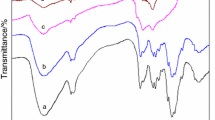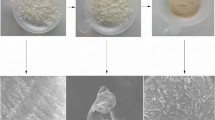Abstract
The thermal dehydration and degradation of chitosan and citralidene chitosan was studied by differential scanning calorimetry at four different heating rates; 5, 10, 15 and 20 K min−1. The kinetics of thermal dehydration and degradation of chitosan and citralidene chitosan was investigated using different isoconversional and maximum rate (peak) methods viz. Kissinger–Akahira–Sunose (KAS), Tang, Starink1.95, Starink1.92, Flynn–Wall–Ozawa (FWO) and Bosewell. The activation energy values of thermal dehydration and degradation reactions obtained from isoconversional methods of FWO and Bosewell are slightly higher than that obtained from other methods. The variation of activation energy, E α with conversion function, α, established using these different methods were found to be similar. Compared to the FWO method, the KAS method offers a significant improvement in the accuracy of the E a values. All the maximum rate (peak) methods yielded consistent values of E α for the dehydration and degradation reactions of both chitosan and CIT-chitosan





Similar content being viewed by others
References
Muzzarelli RAA (1973) Natural chelating polymers. Pergamon Press, Oxford, p 254
Amit B, Milka S (2009) Applications of chitin- and chitosan-derivatives for the detoxification of water and wastewater—a short review. Adv Colloid Interface Sci 152:26–38
Guibal E (2004) Interactions of metal ions with chitosan-based sorbents: a review. Sep Purif Technol 38:43–74
Wu F, Tseng R, Juang R (2010) A review and experimental verification of using chitosan and its derivatives as adsorbents for selected heavy metals. J Environ Manage 91:798–806
Wang FY, Wang H, Ma JW (2010) Adsorption of cadmium (II) ions from aqueous solution by a new low-cost adsorbent—Bamboo charcoal. J Hazard Mater 177:300–306
Kittur FS, Harish PKV, Sankar KU, Tharanathan RN (2002) Characterization of chitin, chitosan and their carboxymethyl derivatives by differential scanning calorimetry. Carbohydr Polym 49:185–193
Peniche C, Carlos E, Roman JS (1998) Interpolymer complexes of chitosan and polymethacrylic derivatives of salicylic acid: preparation, characterization and modification by thermal treatment. Polymer 39:6549–6554
Velyana G, Dilyana Z, Lyubomir V (2012) Non-isothermal kinetics of thermal degradation of chitosan. Chem Central J 6:81–91
de Douglas B (2007) Sergio Paulo C. Kinetics of the thermal degradation of chitosan. Thermochim Acta 465:73–82
Shen-Kun L, Chi-Chih H, Ming-Fung L (2004) A kinetic study of thermal degradations of chitosan/polycaprolactam blends. Macromol Res 12:466–473
Tirkistani FAA (1998) Thermal analysis of some chitosan schiff bases. Polym Degrad Stab 60:67–70
Ikejima T, Yogi K, Inonu Y (1999) Thermal properties and crystallization behavior of poly(3-hydroxybutyric acid) in blends with chitin and chitosan. Macromol Chem Phys 200:413–421
Chun-Yan O, Chao-Hua Z, Si-Dong L, Lei Y, Jing-Jing D, Xue-Liu M, Mu-Ting Z (2010) Thermal degradation kinetics of chitosan-cobalt complex as studied by thermogravi-metric analysis. Carbohydr Polym 82:1284–1289
Si-Dong Li, Chao-Hua Z, Jing-Jing D, Chun-Yan O, Wei-Yan Q, Lei Y, Xiao-Dong S (2010) Effect of cupric ion on thermal degradation of quaternized chitosan. Carbohydr Polym 81:182–187
Coats AW, Redfern JP (1964) Kinetic parameters from thermogravimetric data. Nature 201:68–69
Vlaev L, Nedelchev N, Gyurova K, Zagorcheva M (2000) A comparative study of non-isothermal kinetics of decomposition of calcium oxalate monohydrate. J Anal Appl Pyrol 81:253–262
Atanassov A, Genieva S, Vlaev L (2010) Study of the thermooxidative degradation kinetics of tetrafluoroethylene-ethylene copolymer filled with rice husks ash. Polym Plast Technol Eng 49:541–554
Boonchom B, Puttawong S (2010) Thermodynamics and kinetics of the dehydration reaction of FePO4·2H2O. Phys B 405:2350–2355
Boonchom B, Thongkam M (2010) Kinetics and thermodynamics of the formation of MnFeP4O12. J Chem Eng Data 55:211–216
He W, Deng F, Liao G-X, Lin W, Jiang Y-Y, Jian X-G (2010) Kinetics of thermal degradation of poly(aryl ether) containing phthalazinone and life estimation. J Thermal Anal Calorim 100:1055–1062
Vyazovkin S, Sbirrazzuoli N (2002) Isoconversional analysis of the non-isothermal crystallization of a polymer melt. Macromol Rapid Commun 23:766–770
Vyazovkin S, Sbirrazzuoli N (2003) Estimating the activation energy for non-isothermal crystallization of polymer melts. J Therm Anal Calorim 72:681–686
Starink MJ (2003) The determination of activation energy from linear heating rate experiments: a comparison of the accuracy of isoconversion methods. Thermochim Acta 404:163–176
Vyazovkin S, Sbirrazzuoli N (2004) Isoconversional approach to evaluating the Hoffman-Lauritzen parameters (U* and Kg) from the overall rates of non-isothermal crystallization. Macromol Rapid Commun 25:733–738
Khawam A, Flanagan DR (2005) Role of isoconversional methods in varying activation energies of solid-state kinetics: II. Non-isothermal kinetic studies. Thermochim Acta 436:101–112
Vyazovkin S (2006) Model-free kinetics, staying free of multiplying entities without necessity. J Therm Anal Calorim 83:45–51
Vyazovkin S, Sbirrazzuoli N (2006) Isoconversional kinetic analysis of thermally stimulated processes in polymers. Macromol Rapid Commun 27:1515–1532
Starink MJ (2007) Activation energy determination for linear heating experiments: deviations due to neglecting the low temperature end of the temperature integral. J Mater Sci 42:483–489
Simon P (2004) Isoconversional methods. J Therm Anal Calorim 76:123–132
Joraid AA, Abu-Sehly AA, El-Oyoun MA, Alamri SN (2008) Non-isothermal crystallization kinetics of amorphous Te51.3As45.7Cu3. Thermochim Acta 470:98–104
Akahira T, Sunose T, Trans joint convention of four electrical Institutes, paper no. 246 (1969) Research report, Chiba Institute of Technology. Sci Technol 1971(16):22–31
Kissinger HE (1957) Reaction kinetics in differential thermal analysis. Anal Chem 29:1702–1706
Aboulkas A, El Harfi K, El Bouadili A, Benchanaa M, Mokhlisse A, Outzourit A (2007) Kinetics of co-pyrolysis of Tarfaya (Morocco) oil shale with high-density polyethylene. Oil Shale 24:15–33
Murray P, White J (1955) Kinetics of the thermal dehydration of clays IV. Thermal analysis of the clay minerals. Trans Br Ceram Soc 54:204–238
Tang W, Liu Y, Zhang H, Wang C (2003) New approximate formula for Arrhenius temperature integral. Thermochim Acta 408:39–43
Starink MJ (1996) A new method for the derivation of activation energies from experiments performed at constant heating rate. Thermochim Acta 288:97–104
Flynn J, Wall LA (1966) A quick, direct method for the determination of activation energy from thermogravimetric data. Polym Lett 4:323–328
Ozawa T (1965) A new method of analyzing thermogravimetric data. Bull Chem Soc Jpn 38:1881–1886
Doyle C (1961) Kinetic analysis of thermogravimetric data. J Appl Polym Sci 5:285–292
Boswell PG (1980) On the calculation of activation energies using a modified Kissinger method. J Therm Anal 18:353–358
Kissinger HE (1956) Variation of peak temperature with heating rate in differential thermal analysis. J Res Nat Bur Stand 57:217–221
Vyazovkin S, Burnham AK, Criado JM, Pérez-Maqueda LA, Popescu C, Sbirrazzuoli N (2011) ICTAC kinetics committee recommendations for performing kinetic computations on thermal analysis data-review. Thermochim Acta 520:1–19
Rao CNR (1963) Chemical applications of infra red spectroscopy. Academic Press, New York, p 365
Starink MJ, Van Mourik P (1992) Cooling and heating rate dependence of precipitation in an Al–Cu alloy. Mater Sci Eng A 156:183–194
Starink MJ (1997) On the applicability of isoconversion methods for obtaining the activation energy of reactions within a temperature dependent equilibrium state. J Mater Sci 32:6505–6512
Jose´ ES, Dockala ER, Cavalheirob ETG (2005) Synthesis and characterization of schiff bases from chitosan and salicylaldehyde derivatives. Carbohydr Polym 60:277–282
Jin X, Wang J, Bai J (2009) Synthesis and antimicrobial activity of the schiff base from chitosan and citral. Carbohydr Res 344:825–829
Jiao TF, Zhou J, Zhou JX, Gao L, Xing YY, Li X (2011) Synthesis and characterization of chitosan-based schiff base compounds with aromatic substituent groups. Iran Polym J 20:123–136
Shah HV, Babb DA, Smith DW Jr (2000) Bergman cyclopolymerization kinetics of bis-ortho-diynylarenes to polynaphthalene networks. A comparison of calorimetric methods. Polymer 41:4415–4422
Muraleedharan K, Kripa S (2014) DSC kinetics of the thermal decomposition of copper(II) oxalate by isoconversional and maximum rate (peak) methods. J Therm Anal Calorim 115:1969–1978
Crini G, Badot P (2008) Application of chitosan, a natural amino polysaccharide, for dye removal from aqueous solutions by adsorption processes using batch studies: a review of recent literature. Prog Polym Sci 33:399–447
Sashiwa H, Shigemasa Y (1999) Chemical modification of chitin and chitosan 2; preparation and water soluble property of N-acylated or N-alkylated partially deacetylated chitins. Carbohydr Polym 39:127–138
Guinesi LS, Cavalheiro ETG (2006) Influence of the degree of substitution in biopolymeric Schiff bases on the kinetic of thermal decomposition by non-isothermal procedure. Thermochim Acta 449:1–7
Author information
Authors and Affiliations
Corresponding author
Rights and permissions
About this article
Cite this article
Muraleedharan, K., Alikutty, P., Abdul Mujeeb, V.M. et al. Kinetic Studies on the Thermal Dehydration and Degradation of Chitosan and Citralidene Chitosan. J Polym Environ 23, 1–10 (2015). https://doi.org/10.1007/s10924-014-0665-8
Published:
Issue Date:
DOI: https://doi.org/10.1007/s10924-014-0665-8




